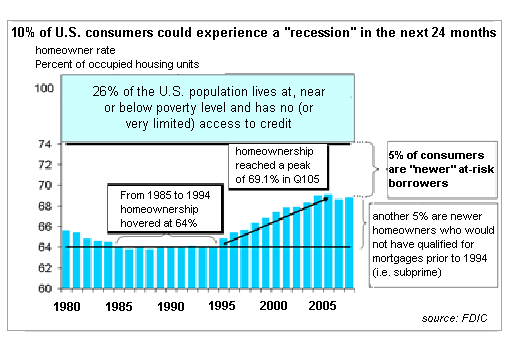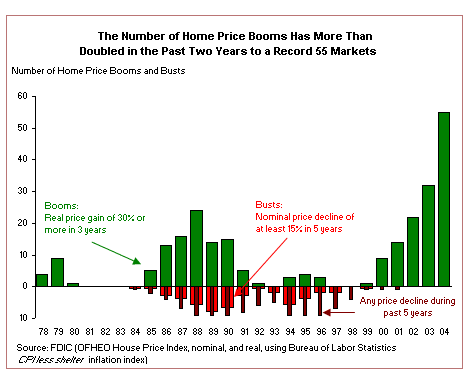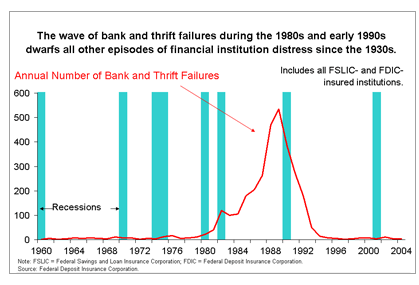

|
| weblog/wEssays archives | home | |
|
Foreclosures and Financial Ruin: How Bad Will It Get? (April 26, 2006) As stories of rising foreclosures become commonplace, one question comes to the fore: how bad will it get? A good place to start looking for answers is the government agencies tasked with safeguarding both depositors and lenders: the well-known guarantor of bank deposits, the Federal Deposit Insurance Corporation (FDIC), and one of the most obscure agencies within the Federal Government, the U.S. Treasury's Office of Thrift Supervision (OTS). Just to give you an idea of these agencies' research, consider this report from the FDIC: Scenarios for the Next U.S. Recession. Here's a very interesting chart from the report: 
* * * * * * * * * * * * * * * * * * * * * Here's what the graph says in simple terms: only 74% of U.S. households are above the poverty line, and 69.1% are homeowners. In other words, just about everyone who has a paycheck above poverty level has bought a house. Homeownership, remarkably stable for years at 64%, suddenly leaped to 69.1% in the past 10 years. And who were those buyers? People who could not have qualified for a mortgage before standards were lowered. This revelation reminds me of the Vietnam-era draft. When the Pentagon needed warm bodies, standards dropped to near zero. At my pre-induction physical in 1972, they were basically checking to see if you had four limbs and could walk upright. If so, you were good to go. The same cursory standards have been applied to mortgages for the past few years, with the predictable result that poor risks are turning out to be, well, poor risks. As the Denver Post recently reported: "We made it easy for people to buy houses and difficult for them to hold onto them," said Tom Clark, an executive vice president with the Metro Denver Economic Development Corp. One out of 128 homes in Adams County is in foreclosure, nearly nine times the national ratio.The FDIC staff reckons 10% of consumers will experience a "recession" (a polite term, apparently, for losing your home and/or suffering complete financial ruin). But as the Post article notes, a rising wind of foreclosures generates its own downdrafts. That rather obvious feedback loop has ominous overtones, so the FDIC staff set out to prove all was well with a report entitled U.S. Home Prices: Does Bust Always Follow Boom? The FDIC, predictably, concluded that busts were uncommon; but their chart reveals an unmistakably unprecedented housing bubble has formed in the past five years: 
* * * * * * * * * * * * * * * * * * * * * * * The body of the report reaches the same conclusion--that housing has leaped far above inflation and rents: U.S. average home prices rose by almost 11 percent in 2004. Adjusted for inflation, the price of the average home in the sample increased by 8 percent–the fastest pace recorded in 30 years. Last year, home prices rose 11 percent, but rents only increased by 2.7 percent nationwide. In 2003, the 7 percent gain in home prices also outstripped a 2.4 percent gain in rents.If that doesn't define a bubble, then what does? Once upon a time, the NSA (National Security Agency) was such a closely guarded secret that even its very existence and name were secret. The OTS reminds us that obscure (and not even secret) agencies wield all sorts of arcane power--for instance, the Office of Thrift Supervision, which, as far as I can gather, is tasked with establishing the risks faced by mortgage lenders ("thrifts"). Reader Jon O., whose powers of financial analysis far exceed my own, sent me these links to Office of Thrift Supervision's Statistical Releases, and suggested I check out what risks the OTS foresaw should a "rate shock" (i.e. an increase in mortgage rates) occur. Toward this end, I read the Quarterly Review of Interest Rate Risk he sent along and found these fascinating comments: "The third quarter saw the ARM (adjustable rate mortgage) share of total mortgage originations rise to 43%... The number of thrifts with significant or high interest rate risk rose to 23 in the 3rd quarter, up from 16 the prior quarter."  This number is not a big deal when you consider they found 666 (a highly ominous number) thrifts to be low risk,
but it's still a 50% increase in only one quarter.
This number is not a big deal when you consider they found 666 (a highly ominous number) thrifts to be low risk,
but it's still a 50% increase in only one quarter.
But the truly salient point is that almost half of all recent mortgages are adjustable rate loans, meaning that the people who took on these mortgages will be fully exposed to higher rates via future resets. As I asked in yesterday's entry: what happens if rates rise from 5.5% to 8.5% or even 10%? Mortgage payments rise--a lot. But that's just the damage rising rates will wreak on homeowners. Rising rates will devastate lenders, too. The OTS is forecasting that lenders' Net Portfolio Value (NPV) will drop by 30% if interest rates rise 300 basis points (3%). Well, the rates are already up nearly a point in less than a year; in the OTS estimation, lenders' portfolios have already dropped 8% in value. Why do we care? Because as lenders' assets drop, they get nervous about taking on new loans. And their trigger fingers get real itchy when it comes to dumping foreclosed properties. As the accompanying chart reveals, massive numbers of thrifts have failed in recent history. The financial cheerleaders are quick to reassure you that such a calamity can never happen again, but if you examine the evidence, such reassurances suddenly sound awfully thin. For one final bit of evidence, read this excerpt from Barron's 1/20/06 issue: Some 43% of first-time buyers, David Rosenberg of Merrill Lynch recounts, put zero money down on their home purchases last year; by contrast, two years earlier, 28% bought a house with no down payment. Well over a quarter of the mortgages in '05 were of the dicey "buy now, pay later" variety.So let's summarize: the number of risky thrifts is rising rapidly; rising interest rates sap the value of the thrifts' portfolios, pushing them into the "risky" column; almost half of all recent mortgages are adjustable, meaning homeowners are hugely at risk of rising interest rates, and to cap off the entire house of cards, over 40% of recent home buyers put no money down. If all that doesn't add up to high risk, then what else do you need? Oil at $70 a barrel? $400 billion Federal deficits? A waning foreign appetite for U.S. bonds? An $800 billion trade deficit? By strange coincidence, we got 'em all. For more on this subject and a wide array of other topics, please visit my weblog. copyright © 2006 Charles Hugh Smith. All rights reserved in all media. I would be honored if you linked this wEssay to your site, or printed a copy for your own use. |
||
| weblog/wEssays | home |